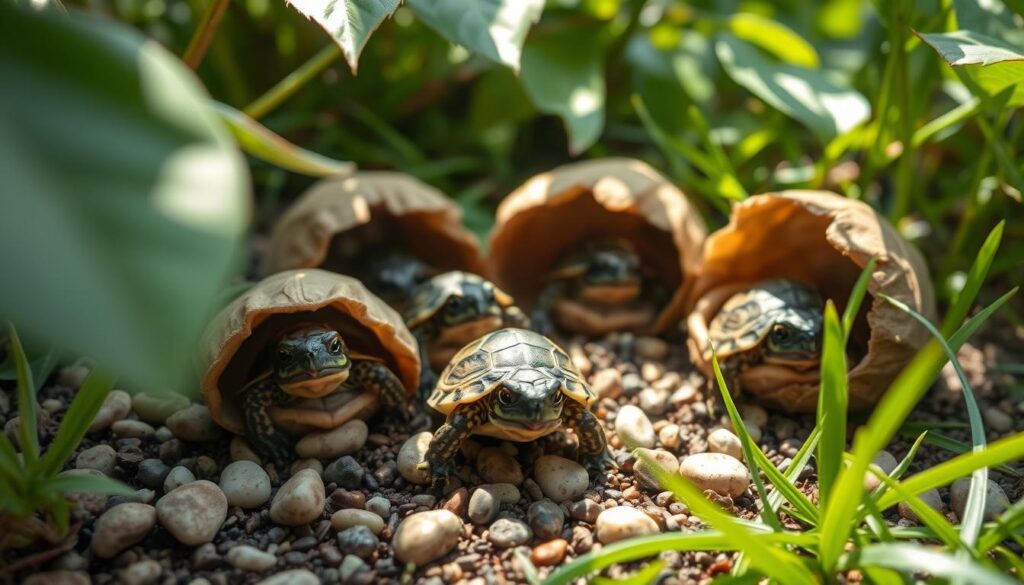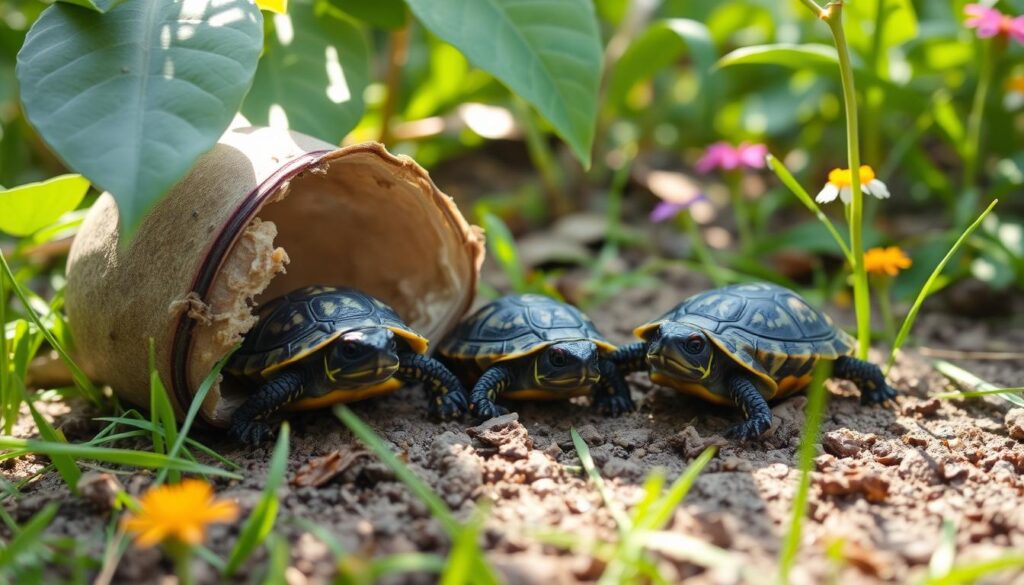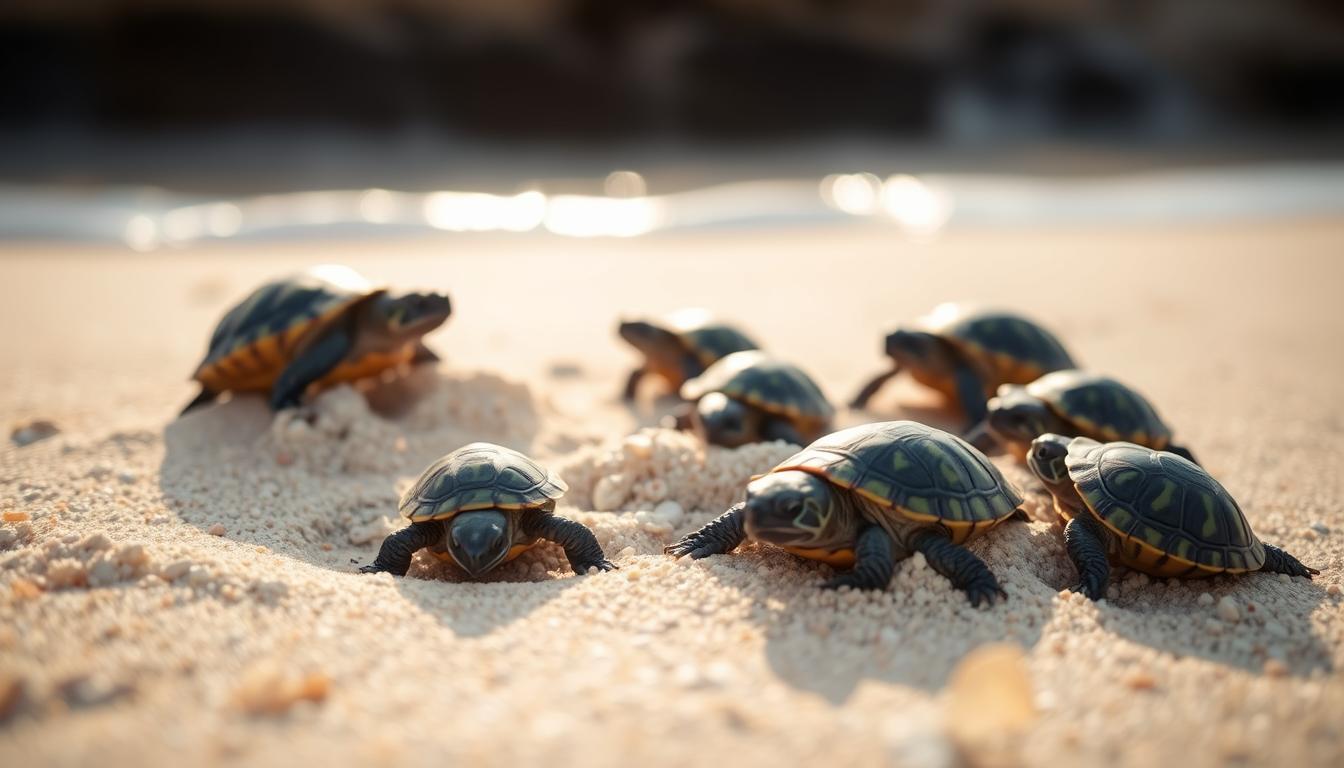Did you know box turtles can live up to 50 years in the wild? Some even reach over 100 years old. These reptiles are not often kept as pets because they need special care. But their long lives and unique traits make them very interesting.
Newborn box turtles come out of their eggs and hide under leaves for years. They eat worms, beetles, and bugs, which are all meat. This diet helps their shells grow strong, and they get moisture from their food.
Some baby turtles stay in their nests through their first winter. They wait for spring rains to come out. This time is very important for them as they face survival challenges and get ready for their long lives.
Table of Contents
Understanding Box Turtle Hatchlings in the Wild
Learning about the natural world of newborn box turtles is key to understanding their struggles. These small turtles, with their unique domed shells, face many dangers. They must survive and grow in a tough environment.
Natural Habitat and Environment
Box turtle babies come out of their nests, often hidden under leaves or soil. They live in green, wooded areas. But, their soft shells make them vulnerable to predators like raccoons, foxes, and birds.
Only a small number of these young turtles will grow up to have babies of their own. This shows how hard it is for them to survive in the wildlife conservation of chelonians.
Early Life Behaviors
Newborn box turtles have strong instincts to stay alive. Female turtles lay their eggs in many places during summer. They also make “false nests” to trick predators.
The nest’s temperature decides if the hatchlings are male or female. Cooler nests make males, while warmer ones make females.
Survival Challenges
Box turtle eggs incubate for 60-70 days. During this time, the babies grow in their soft shells. After they hatch, they face many dangers.
They must avoid predators and get used to their surroundings. Losing their homes and human actions hurt their numbers. This makes turtle care and conservation very important.
“It’s crucial to appreciate the delicate balance of the natural world and the unique challenges faced by young box turtles. By understanding their behaviors and habitat needs, we can better protect these remarkable creatures and ensure their continued survival in the wild.”
The Fascinating Birth Process of Box Turtles
Box turtles have a birth process that is truly captivating. They incubate for 60 to 70 days. The temperature affects whether they are male or female.
At cooler temperatures, between 72°F and 93°F, the eggs hatch into males. Higher temperatures mean females. The middle range can have either sex, showing nature’s balance.
The hatching process is amazing to see. It can take a few hours or several days. After hatching, the young turtles eat the egg yolk for nutrition.
“The birth process of box turtles is a true testament to the adaptability and resilience of these remarkable creatures.”
Learning about turtle breeding, turtle incubation, and turtle nesting helps us appreciate their journey. It’s a remarkable start to their lives.
Essential Care Requirements for Newborn Box Turtles
Caring for newborn box turtle hatchlings is a big responsibility. They need the right temperature, humidity, and water. Knowing what they need helps keep them healthy and happy.
Temperature and Humidity Control
Keeping the right temperature and humidity is key for their growth. The tank should have a temperature range of 70°F-75°F at the cooler end and 90°F-100°F at the basking zone. Also, they need UVB light to make vitamin D3.
Proper Substrate Selection
Baby box turtles need a moist environment for their shells to grow right. Use a mix of coconut coir and sphagnum moss, kept damp with daily mistings. As they grow, you can change the substrate to something drier.
Water and Hydration Needs
Box turtles love water and need it to stay humid. Give them a water dish that’s deep for bathing but easy to get out of. Mist the enclosure often to keep it humid.
| Habitat Requirement | Ideal Specification |
|---|---|
| Tank Size for Newborns | 20-gallon aquarium |
| Temperature Gradient | 70°F-75°F (cooler end) to 90°F-100°F (basking zone) |
| UVB Light Range | 290–320 nanometers |
| UVB Light Placement | 12–18 inches from the turtle |
| Substrate | Coconut coir and sphagnum moss, kept damp |
| Water Dish | Deep enough for bathing, with easy exit |
Managing temperature, humidity, and water access is vital. It helps create a safe and nurturing space for newborn box turtles. Meeting these needs is essential for their health and happiness.
Dietary Needs and Feeding Schedule
Understanding the dietary needs of newborn box turtles is key. These chelonians are omnivorous. They eat a mix of insects, plants, fungi, and even carrion in the wild.
In captivity, you can give your baby box turtle a variety of foods. This includes live insects like woodlice and cockroaches. You can also add dampened turtle pellets to their diet.
- A balanced diet includes lean beef, vegetables, hard-boiled egg, turtle pellets, and reptile vitamins.
- Feed baby turtles every other day, and adults every two to three days.
- Serve food on rough dishes or slate to help maintain beak health.
| Food Type | Proportion in Diet |
|---|---|
| Plant Material | More than 50% |
| Commercial Pellets | About 25% |
| Live Food | About 25% |
Turtles need a balanced diet for good nutrition. Vitamins or supplements are usually not needed if you use high-quality pellets.
“The approximate amount of food any turtle should eat daily is about 3 percent of their body weight.”
By following these dietary guidelines and feeding schedules, you can ensure your baby box turtles receive the nourishment they need. This will help them grow into healthy adult chelonians.
Creating the Perfect Habitat for Baby Turtles
Creating the right habitat is key for your baby turtle’s well-being and growth. Whether you have one or a few, it’s important to mimic their natural home. Let’s look at the essential parts of setting up the perfect habitat for your baby turtle.
Enclosure Setup
A glass terrarium is a great choice for housing your baby turtle. It helps keep the humidity levels high, which box turtles need. Make sure the tank is big enough for your hatchling to grow and move around.
Lighting and Heating Requirements
Lighting and heating are vital for your baby turtle’s health and growth. Use a UVB light for vitamin D3 and bone health. Add an under-tank heating mat for a basking spot between 32-35°C (90-95°F). Keep the lighting on for 10-12 hours a day to match their natural day.
Safety Considerations
Box turtles are good climbers, so your enclosure must be escape-proof. Use heavy objects or clips to keep the lid secure. Also, watch out for sharp edges or objects that could harm your baby turtle.
By focusing on these habitat setup aspects, you’ll create a safe and thriving environment for your newborn box turtle. Remember, the right conditions are crucial for your reptile hatchling’s long-term health and well-being.
Growth and Development Stages
Newly-hatched newborn box turtles are about the size of a quarter. Their shells are soft and pliable at first. As they grow, they become harder.
Young baby turtles don’t have the defenses of adults. They stay hidden and blend in to protect themselves.
As chelonians age, they develop a hinged plastron. This lets them close their shells for protection. This is how they got their name.
The average size of a Florida box turtle is about 11 cm x 8 cm. The common box turtle is around 15 cm x 10 cm. The Gulf Coast box turtle can grow up to 18 cm x 12 cm.
Box turtles grow about 1.5 cm per year in the first five years. They can live over 100 years. Females and males reach sexual maturity around 5 years old.
Nest temperature is key in determining the sex of baby turtles. Cooler nests (22-27°C) produce more males. Warmer nests (above 28°C) favor females.
| Box Turtle Species | Average Size |
|---|---|
| Florida Box Turtle | 11 cm x 8 cm |
| Common Box Turtle | 15 cm x 10 cm |
| Three-Toed Box Turtle | Similar to Common Box Turtle, but with a more narrow shell |
| Gulf Coast Box Turtle | 18 cm x 12 cm |
Box turtles may lay 3 to 8 eggs per clutch, with an average of 4-5 eggs. The incubation period and hatchling emergence vary by species and environment. As they grow, these fascinating newborn box turtles and baby turtles develop their unique traits and adaptations.

Common Health Issues and Prevention
Caring for newborn box turtles means watching their shell grow and their health closely. It’s important to make sure they get enough UVB light and calcium to avoid metabolic bone disease. Also, watch out for respiratory infections, especially in cold weather. Keeping their home clean and the right humidity helps prevent shell rot and fungal infections.
Shell Development
Box turtle babies have soft shells that get harder as they grow. Give them a UVB light and a diet rich in calcium. This helps them grow strong shells and avoid metabolic bone disease.
Disease Prevention
Respiratory infections and shell rot are big worries for box turtle babies. Keep their home at the right temperature and humidity. Watch for signs like wheezing or open-mouth breathing, and get vet help if you see them.
When to Seek Veterinary Care
If your turtle’s eating habits change, their shell looks off, or they have breathing trouble, see a vet right away. Reptile vets can help keep your turtles healthy and happy.
| Health Issue | Symptoms | Prevention | Treatment |
|---|---|---|---|
| Metabolic Bone Disease | Soft, deformed shell, lethargy, loss of appetite | Proper UVB lighting, calcium-rich diet | Calcium and vitamin D3 supplementation, veterinary care |
| Respiratory Infections | Wheezing, open-mouth breathing, nasal discharge | Maintain proper temperature and humidity | Antibiotic treatment, supportive care |
| Shell Rot | Discoloration, flaking, or erosion of the shell | Clean, well-maintained enclosure, proper humidity | Antifungal treatment, veterinary care |
By being careful and quick to act on health issues, you can keep your newborn box turtles healthy and happy.
Natural Behaviors of Newborn Box Turtles
Newborn box turtles know how to move around. At first, they might be shy but can get to trust people. They love digging and hiding, so they need deep places to do so.
They often take their food to the water and go there to poop. This is just how they are.
As they grow, baby turtles become braver and might even come to people for food. This shows they can adapt and connect with humans. It’s key to understand and support these natural actions for their care and wildlife conservation.
| Turtle Species | Age at Sexual Maturity | Eggs per Clutch | Incubation Time |
|---|---|---|---|
| False Map Turtle | 2-3 years | N/A | N/A |
| Common Snapping Turtle | 10-12 years | 20-30 | N/A |
| Green Sea Turtle | 24-28 years | N/A | N/A |
| Leatherback Sea Turtle | N/A | 50-90 | N/A |
| Hawksbill Sea Turtle | N/A | 140-160 | N/A |
| Aldabran Tortoise | N/A | 12-14 | N/A |
| Suwanee Cooter | N/A | 15-20 | N/A |
Most turtles take 45 to 75 days to hatch, and some eggs can wait up to 12 months before hatching.
“Only one in a thousand young turtles ever reaches reproductive age, highlighting the immense challenges faced by these remarkable creatures in their early stages of life.”
Box turtles can close their shells as they grow. Female box turtles might travel half a mile to find the right place to nest in summer.
Habitat loss and human actions are big threats to box turtles. It’s vital to protect their homes and teach people to care for them responsibly. This helps these amazing reptiles survive for a long time.

Conservation and Protection Measures
Box turtles, also known as terrapins or chelonians, face threats from habitat loss and human interference. Conservation efforts are key to protect these remarkable creatures. Their small home territories and slow maturation rate make them vulnerable to environmental changes and human impacts.
Threats to Survival
Urbanization, deforestation, and agricultural expansion have reduced box turtles’ natural habitats. The pet trade and vehicle collisions also threaten their survival. Taking box turtles from the wild disrupts their ecosystem and leads to declining populations.
Conservation Efforts
Conservation organizations and wildlife agencies have launched various strategies to protect box turtles. They focus on preserving habitats, educating the public, and enforcing laws against illegal collection and trade.
How to Help
- Support local conservation organizations and volunteer for habitat restoration projects.
- Avoid purchasing box turtles as pets, as this encourages the illegal wildlife trade.
- If you encounter a box turtle in the wild, leave it undisturbed in its natural habitat.
- Report any illegal wildlife activities or habitat destruction to the appropriate authorities.
- Spread awareness about the importance of box turtle conservation and the threats they face.
By working together, we can ensure box turtles thrive in their natural habitats for generations. Your actions, no matter how small, can make a significant difference in wildlife conservation.
Conclusion
Caring for newborn box turtles needs a deep understanding of their needs. This includes setting up the right habitat and feeding them properly. It also means keeping them healthy and supporting their survival.
In this guide, you’ve learned about box turtle development and their natural behaviors. It’s important to keep their environment right, with the right temperature and humidity. Also, feeding them a balanced diet is key.
By caring for newborn box turtles, you help protect these amazing reptiles. Your efforts in responsible care and wildlife preservation are crucial. They ensure box turtles continue to thrive for future generations.


1 thought on “Discover Everything About Newborn Box Turtles”